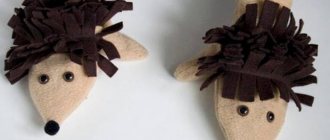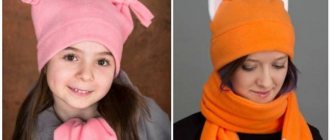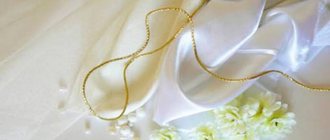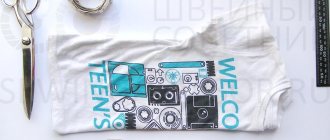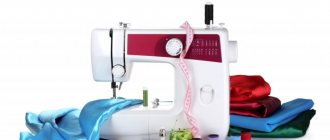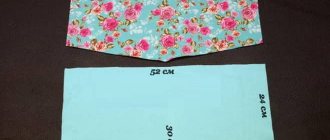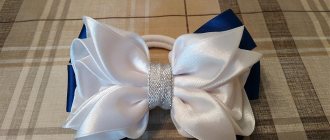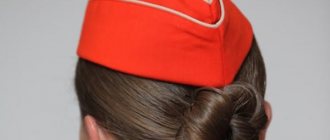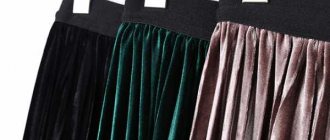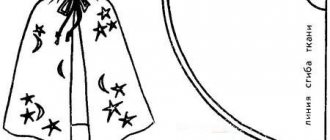House shoes are increasingly gaining popularity.
It’s so nice to dive into warm, cozy fleece boots after a hard day. They will come in handy on cool evenings at the dacha or during battery outages. You can easily sew home shoes with your own hands; these can be boots (ugg boots), slippers, slippers.
To make ugg boots, the following warm material is useful:
- Fleece, velsoft, fur, felt.
- Insulation: synthetic winterizer, alpolux, batting.
- Sole: leather, suede, leather substitute, anti-slip fabric with rubber pimples.
- The threads are strong.
- Edging tape.
If desired, ugg boots can be decorated with ears, bows or in an ethnic style.
An easy way to determine your foot size
Take a piece of paper and trace your baby's foot with a pencil. By adding one centimeter to the contour of the resulting foot model for freedom of fit, you will get the desired bootie size. Calmly knit your booties using this pattern without bothering your little one with fittings.
If it is not possible to measure the leg, then we will give you approximate dimensions to help:
- 9 cm – 0-3 months;
- 10 cm – 3-6 months;
- 11.5 cm – 6-9 months.
Booties are something between a sock and a boot. Therefore, their appearance depends only on your knitting skills and flight of fancy. The boots can be knitted with a solid fabric, or with buttons, ties, or ribbons.
You can also combine dense knitting with openwork elements, use different textures in one product, add decor in the form of beads, knitted flowers and other decorations.
The main thing is to use small decor correctly and securely, so that the child is not tempted to tear off all this beauty while playing.
Knitted booties still remain the most comfortable, cozy, original accessories that convey to the baby the warmth of hands, the energy of love and care, maternal patience and vitality.
This is interesting: Pattern for baby booties (age 3-6 months)
Stages of pattern construction
The pattern is ready-made, as in the photo below.
If the leg is not standard, for example, a wide foot, a high arch, a protruding bone, then the patterns can be built independently, according to individual measurements.
To construct the sole, you can outline the foot, the insole, or a finished slipper that fits the size.
Attention: if the foot or insole was outlined, then add an additional 1 cm around the circumference. There is no need to increase the sole around the slipper - it is already large.
Size chart
| Number(s) on the pattern | Length, cm | Size |
| 1 | 12 | 19 |
| 2 | 13 | 20 |
| 3 | 14 | 21 |
| 4 | 15,5 | 22,5 |
| 5 | 17 | 25 |
| 6 | 18 | 27 |
| 7 | 19,5 | 30 |
| 8 | 20,5 | 32 |
| 9 | 22 | 34 |
| 10 | 23 | 35 |
Size chart for children's slippers
Description
Sizes 19, 20, 21, 22.5, 25, 27, 30, 32, 34, 35.
Product length along the foot (cm): 12, 13, 14, 15.5, 17, 18, 19.5, 20.5, 22, 23.
Before choosing the size of the pattern, determine the required size as accurately as possible using the size chart. The size is determined by the length of the foot; if necessary, the pattern can be adjusted by a few centimeters.
If you are in doubt about the size, you can take a pattern one size larger, baste the product before sewing and try it on. After trying on, adjust the pattern if necessary.
This pattern is suitable for sewing slippers for a boy or a girl. For the pattern for an adult, see the link at the bottom of the page.
Necessary materials:
To sew homemade children's slippers you will need fabric.
Fabric consumption
Main fabric consumption:
Cut length 0.20-0.20-0.20-0.25-0.25-0.30-0.30-0.30-0.30-0.30 m with a width of 60 cm.
Lining fabric consumption:
Cut length 0.20-0.20-0.20-0.25-0.25-0.30-0.30-0.30-0.30-0.30 m with a width of 60 cm.
Elastic band 10 cm long, two cuts, if necessary.
Allowances:
- Seams – 1 cm.
- For sections – 1 cm.
Uncover
Main fabric:
- Upper part with fold – 2 parts.
- Lower part (foot) – 2 children.
Lining fabric:
- Upper part with fold – 2 parts.
- Lower part (foot) – 2 children.
Ugg boots
This model can be sewn with your own hands from any material - fleece, felt, leftover fur. The best option is an old sheepskin coat. The boots will be elastic, warm, and will keep their shape well.
For work you will need
- cardboard for making patterns;
- pencil, chalk or soap, ruler;
- tailor's centimeter;
- dense material for the sole or seal;
- remnants of an old sheepskin coat;
- thick threads, a needle with a large eye, scissors.
We start making the pattern from the sole. It will determine the parameters of all other parts. If you don’t have such experience, you can use the knowledge of experienced craftswomen.
When cutting, you need to leave seam allowances. For dense material, their width should be 0.5-0.7 cm. It is better to draw lines with a piece of soap with a sharp edge. Its traces are clearly visible, but they are easily removed during the process of sewing boots.
The fur around the edges needs to be cut off. The seam will be soft, the elements will be easy to connect, not only with a hand seam, but also with a sewing machine.
The next stage is connecting the parts. The top parts are sewn together first. Then the top is pinned onto the sole with decorative pins and stitched. It is necessary to prick so that the “landing” is correct and uniform. The center of the heel should coincide with the middle of the heel, the “top” of the toe with the middle part of the toe on the insole.
The sole of homemade UGG boots made from the remains of an old sheepskin coat can be reinforced with an insole made of felt, polyurethane, or rubber. Synthetic insoles are glued to the base fabric using glue.
These homemade boots can be decorated with embroidery, rhinestones, and the seams can be covered with decorative braid. In the front part of the boot, you can decorate the fastener with a button and loop, or a zipper. This solution is suitable for those who have wide legs, high arches, and those who suffer from edema.
How do booties differ from regular boots?
- The boots usually have a high top.
- To make high booties easy to put on, you need to make a clasp.
- They imitate adult shoes - Ugg boots, boots, boots, sneakers, etc.
- Knitted from thick and warm yarn for the cold season.
- They can be either wool blend or fluffy yarn - polyacrylic, polyester.
Where to start knitting
The boots, like ordinary booties, are knitted from the sole. The sole can be knitted according to one of the following patterns:
In our articles you will find other options for sole designs. The size of the sole depends on the age of the child; in order not to make a mistake with the length of the product, follow the approximate size table for children's shoes:
Tip: knit booties - boots to size with a margin, because... Babies grow very quickly; before you know it, they will become too small for the child.
Choosing yarn
Depending on the season and your needs, we will have to choose threads for future booties:
- For winter and off-season, we recommend choosing wool mixture, wool with bamboo and acrylic. You can certainly purchase 100% wool and cashmere, but be sure to check first to see if they are scratchy.
- We recommend buying acrylic for warm autumn/spring, although some parents are sure that only acrylic is suitable for their child. Acrylic is recommended for children who may be allergic to natural wool.
- summer booties are knitted from cotton, but it is better to choose special children's cotton and cotton with additives.
- for premature babies booties - boots are knitted from 100% natural wool! We learned this unusual information at a charity forum. The prickly fur stimulates blood circulation and prevents the child from forgetting to breathe.
Whatever booties you choose, boots or shoes, they will definitely bring warmth and care to your baby!
This is interesting: Pattern for children's boots and booties
DIY children's boots
You can make these wonderful baby booties with your own hands. In order to make such warm boots you need to take several pieces of terry cloth and raincoat fabric. Take measurements from the children's feet so as not to make a mistake with the size. Draw a simple pattern, cut out parts from raincoat fabric and terry cloth. The pattern can be made more spacious so that the boots can easily be put on the baby’s foot, and they are fixed on the foot with a lace that is threaded into a specially sewn loop, this can be seen in the fifth photo. Please note that the part of the boot cut from terry cloth needs to be made a little longer so that you can later make a lapel. Of course, such boots are more suitable for children under one year old who are not yet quite confident on their feet, but if you make the sole thicker, say, cut it from a rubber sole from an old sneaker, then they will be suitable for both children and older ones. And if you increase the size, then I think you can make chuni slippers for adults.
09/26/2017 ViktoriaOrlova
← How to make an Easter egg from felt with your own hands Carpet with a road for cars →
ideikin.ru
Product assembly
The main fabric of this model is fleece with a brown pattern, the lining is the same, only gray. Insulation – thin padding polyester. The sole is anti-slip “foot” fabric.
Sole assembly
Fold the layers of the sole in the following order: fleece, insulation, leather or anti-slip fabric. Stitch them together.
There are two ways to connect the sole to the main product: with seams outward or seams inward.
Processing with seams inside
The advantage of this treatment is a very neat appearance. Nothing is visible from the outside.
Negative aspects: due to the fact that thick seams are located on the inside, there is a decrease in space in the shoes and their size decreases. They can interfere with the foot when walking if the boot is not large enough.
The parts are connected as follows:
Important: the thickness of the sole layer is quite significant, so it is advisable to stitch this area manually or using an industrial sewing machine. A household machine may not be able to handle it.
Processing with seams facing out
The advantage of this treatment is that the foot in the boot is very comfortable, the thickness of the seams does not interfere with it.
Master Class
We've sorted out the basics, now it's worth talking about a more serious approach to this matter. The first step is to decide on the shoe model, since the choice of materials used depends on this. Then you need to buy the following materials: fleece, leatherette, felt, threads, needles and scissors, respectively. This is an optional list, you can buy any other soft and pleasant to the touch material for the base of your product.
You can make the inside very soft and the outside much harder so that the shoes have clear contours. The next stage is the patterns. The above has already described in detail how and what to do, the only thing worth adding is that you can use your old shoes to draw the insoles; to do this, you need to put the shoes on a sheet of paper and trace the outline. In this case, there is no need to make an allowance. Another option is to buy an insole in a store.
Note. When choosing an insole, do not rely on the size indicated on the label. To make a quality choice, you need to carry with you a centimeter ruler or a pocket tape measure - a keychain, this will allow you not to make a mistake.
After finishing working with the drawings of the parts, they need to be cut out of paper and transferred to the prepared material. Once you have cut out all the necessary parts from the material, you can start stitching. All parts must be sewn with the seams facing out, leaving holes in the place where the shoes will be put on the foot and for the insole.
Since in the future the resulting “boots” will need to be turned inside out with the seams. When you have sewn all the parts, you need to sew them on a sewing machine, and sew the sole to them, which we also sew with the seams facing out. We do this with both categories of parts (external and internal). The resulting 2 parts are sewn together right sides together, then turned inside out through the previously left holes.
DIY homemade fleece boots
Let's start making patterns in a way we already know. We sew and overcast the resulting parts. We sew all the parts together. The only and main difference from ordinary boots is that here your imagination is not limited by anything. You can literally experiment, and no one will tell you anything for it. One of the common additions are ears on the sides of the slippers and eyes on the front. All these parts are also made of soft material.
This is interesting. If it is necessary to give the part hardness, plastic can be sewn inside. Where can I get plastic? Cut any old plastic document folder into the parts you need. This plastic is quite hard and holds its shape. If necessary, you can use several layers.
The resulting house shoes can be decorated in any way you like. Using various colored ribbons and beads, you can create a simple, beautiful pattern that will please your eyes.
Reference. When choosing a material for the sole, you need to consider what you will use these slippers for. If a lot of walking is not expected in them, then the sole can be made of felt. This is quite dense, but at the same time soft material.
If you plan to wear them every day, then it is better to opt for leather soles. There are many variations of the material, the denser it is, the better. Feet in shoes with leather soles actually do not get tired even with prolonged wear, and the leather is also breathable.
The most romantic outfits for Valentine's Day for women 30+
Linen dress styles
How to sew children's boots from fleece yourself
Fleece shoes will come in very handy for kids. This is a soft, delicate and warm material.
The patterns are built according to the same principle as for an adult. But since children’s legs in most cases have a standard shape, you can take a ready-made pattern of a suitable size.
Sewing homemade fleece boots for kids is a pleasure. They are made in various bright colors, in the form of animals with faces and ears.
For very tiny ones, ugg boots are sewn with the seams facing out. For the sole, it is advisable to use anti-slip fabric or suede. Because they provide stability and prevent slipping.
The video will clearly show another way to create a pattern and sew house shoes.
How to sew fleece boots with your own hands
House shoes are increasingly gaining popularity. It’s so nice to dive into warm, cozy fleece boots after a hard day. They will come in handy on cool evenings at the dacha or during battery outages.
You can easily sew home shoes with your own hands; these can be boots (ugg boots), slippers, slippers.
To make ugg boots, the following warm material is useful:
If desired, ugg boots can be decorated with ears, bows or in an ethnic style.
Booties - boots, works from our site
Knitted booties - boots. Yana's work
Booties - “Scales” boots are crocheted from wool blend yarn. The sole consists of two knitted elements; between the knitted layers there is a dense material to maintain the shape. The lower part is knitted in a circle with relief posts. The upper part is
Read more…
Booties ugg boots crochet. Roxanne's work
Booties - UGG boots, knitted on a leg 9-10 cm, bottom - acrylic/wool, top - children's acrylic, hook No. 2. Booties - boot soles: cast on 15 VP and knit according to the pattern, then 1 row of lifting hdc, 2 rows of sc, and from the next row (fourth) we make
Read more…
Master class from Oksana Usmanova on knitting boots
Crochet booties and boots “Chickens are counted in the fall...” Master class! Let's do the math... Hello, fashionistas! I would like to present to you my work - funny booties - boots (hen with chicks). Made from yarn "YarnaArt Jeans" 160m x 50g, 55% cotton, 45% polyacrylic. Gone (cumulatively)
Read more…
Booties for girls
Hello! My name is Olesya! I've been into crocheting for a couple of years now, and I especially love crocheting for kids. I offer booties for girls for the competition. This is an original work. They are very dense and warm, which is very important in view of the upcoming
Read more…
Bright knitted boots. Work by Elena Zubkova
I present to you my very favorite booties - boots that I knitted thanks to Marina Salakhova. Very warm and easy to make. Let's begin. We will need any children's threads (Yarn Art baby, children's novelty, baby nako, etc.
Read more…
Knitted booties - boots for girls. Work by Yulia Galetskaya
Booties - boots for girls with feet 9 cm. For work I used yarn "Pekhorka children's novelty" 100% acrylic soft pink, hook No. 2.5. For the binding I took from the reserves “Yarn from Troitsk” of the “Acacia” series, red, 100% acrylic
Read more…
Knitted booties - boots. Oksana's work
Hello! I'm Oksana. I got knitted for booties - boots, knitted them without a pattern, saw similar ones on the Internet and decided to knit them. I knitted the sole according to the pattern. I tied it behind the back segments with white thread - 5 rows of st.b.n. in a circle, folded
Read more…
Booties are boots with buttons. Work by Yulia Galetskaya
Booties - boots for girls with 10 cm feet. Knitted to order for the holiday. For the work I used “Pechorka children's novelty” in soft pink color, 100% acrylic, a pink ribbon for a bow, 2 pink mother-of-pearl beads and pink buttons with mother-of-pearl
Read more…
We sew children's chuni house boots
For children's house boots we will need: fleece for the base (velsoft, fur, velor, etc.), a patch, batting and artificial leather (raincoat, fleece) for the sole.
The pattern is given for sizes 28-30. The height of the boot can be chosen according to your wishes (mine is 13 cm high by 28 cm wide).
Let's start cutting out the details.
We will need for the base (I have blue fleece): two upper parts, two parts for the shaft - cut out two rectangles, two faux leather soles, two batting soles.
For the lining (I have black fleece) you will need: two upper parts, two parts for the boot, two insoles.
We take the main part - the tops and the patch. We fold the part in half and determine the location of the patch so that it is on the side.
We take the top parts and fold them with their right sides facing each other, securing them with pins.
Trim the seam allowances using a zigzag stitch. We take our future slippers, fold them in half with the right sides inward and grind the back part. Don't forget to trim the seam allowances.
Now we take the sole - artificial leather and batting. Fold them towards each other and stitch along the edge.
Now we take the main part of the blue slipper and the sole, and sweep it away carefully.
This is what you should get:
Stitch and trim seam allowances.
The base is ready. Now we also assemble the lining - black fleece. Only at the back of the seam we leave a hole through which we will turn our slipper inside out.
That's it, the lining is ready. Also don't forget to trim the seam allowances.
We insert the lining inside the base so that the right sides are facing each other. And sew the top edge of the seam.
This is what you should get:
Stitch the top edge. We turn the slippers inside out through the hole that we left in the lining.
We sew the hole with a hidden seam.
We insert the inner part of the lining into the base. And everything is ready.
These indoor slippers will always keep your child's feet warm.
Author of the master class Creative workshop Alfa-Mag (https://www.livemaster.ru/alfa-mag)
online-rukodelie.ru
Booties - boots, descriptions from the Internet
Sunflower booties
The description is given for ages from 7 months, not exactly for newborns, but if you reduce the size, you can knit it on a small leg.
Watch the master class at the link
Boots - ugg boots, master class for beginners from alkadav
See the link for step-by-step description
Master class on crocheting booties
The size of the finished booties - boots - 10 cm along the foot (6 months).
Materials:
- 1. Yarn “children's novelty” (200 m, 50 g) in two colors.
- 2. Hook No. 3.
Booties - boots are knitted in 2 threads!
See the link for step-by-step description
Boots from Alize Baby Set Marifetli
A pair of booties uses almost a skein of Alize Baby Set Marifetli yarn.
For a step-by-step description for beginners, see the link.
How to crochet booties with Tunisian crochet
To begin with, dial in 20 air. loops
Photo master class, see the link
Booties - boots Successful
Author of the description: Irina Kostelnyk
Let's get started. To work you will need:
- thread NAKO BAMBINO 25% wool 75% acrylic, 50 g / 130 m
- hook number 3 and for tying the edge 2.5
- buttons for decoration
- wish
Master class for beginners, see the link
Booties for baby
The author of the description is Marina Salakhova.
Yarn acrylic Yarn Art Baby and hook number 2.
Master class for beginners
Warm booties - boots for boys
To knit booties, choose a suitable acrylic yarn; it is ideal for knitting children's clothes, it does not fade or shrink. Threads should be of medium thickness (100-150 m in a skein of 50 g). One skein will be enough. You can also use leftover thread for finishing. In addition to yarn, you will need:
- hook No. 3.5;
- scissors;
- a piece of cardboard;
- 4 flat buttons.
Description of boots
Video tutorials on knitting booties - boots
Knitting booties - Crochet minions for beginners
Summer booties - boots for little explorers! Series "Minions"/Minions. Booties are elegant and at the same time suitable for everyday wardrobe, perfect for both boys and girls. You can wear them either on your socks or instead directly on your bare feet at home or in the summer in hot weather. yarn Sumykamvol cotton 100% in 4 folds. Hook 2.0 mm.
The video should load here, please wait or refresh the page.
How to crochet booties and boots
In this video you will learn how to crochet Crochet Baby Booties. The sole size of the booties is 9 cm. They are knitted for ages 0-3 months. For knitting, I used yarn of two colors Pekhorka “Children's novelty” (100% acrylic, 50 g/200 m) and a hook No. 2.5.
The video should load here, please wait or refresh the page.
